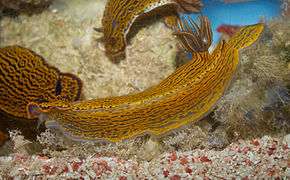Felimare zebra
Felimare zebra, common name the zebra doris, is a colourful species of sea slug or dorid nudibranch, a marine gastropod mollusc in the family Chromodorididae.[1][2]
| Felimare zebra | |
|---|---|
 | |
| Scientific classification | |
| Kingdom: | Animalia |
| Phylum: | Mollusca |
| Class: | Gastropoda |
| Subclass: | Heterobranchia |
| Order: | Nudibranchia |
| Suborder: | Doridina |
| Superfamily: | Doridoidea |
| Family: | Chromodorididae |
| Genus: | Felimare |
| Species: | F. zebra |
| Binomial name | |
| Felimare zebra (Heilprin, 1889) | |
| Synonyms[1] | |
| |
Description
Felimare zebra is a rather large nudibranch and can reach a total length of at least 180 mm (7.1 in). It has a black body with longitudinal orange lines running along the body and dorsum. Its mantle edge is usually white, sometimes dotted with black spots. The gills are a translucent colour outlined in black, and the rhinophores are completely black. There is some colour variation in this species.[5][6] Its similarity to Felimare picta was explored in an investigation into the close relationship of Felimare picta, Felimare bayeri, Felimare tema, Felimare lajensis and Felimare zebra.[7]
Ecology
Minimum recorded depth is 1 m and maximum recorded depth is 18 m.[8] This species feeds on the sponge Dysidea etheria.[9]
References
- Bouchet, P. (2012). Felimare zebra. Accessed through: World Register of Marine Species at http://www.marinespecies.org/aphia.php?p=taxdetails&id=597538 on 2012-05-14
- Johnson R.F. & Gosliner T.M. (2012) Traditional taxonomic groupings mask evolutionary history: A molecular phylogeny and new classification of the chromodorid nudibranchs. PLoS ONE 7(4): e33479
- Thompson, T.E., 1977. The taxonomic status of two Bermudan Opisthobranchs. Journal of Molluscan Studies, 43: 217-222.
- Crozier W. J. (1916). "On the immunity coloration of some nudibranchs". Proceedings of the National Academy of Sciences 2: 672-675.
- Ortea, J., Valdés, Á. & García-Gómez, J.C. (1996). Revisión de las especies atlánticas de la familia Chromodorididae (Mollusca: Nudibranchia) del grupo cromático azul. Avicennia suplemento 1: 1-165 page(s): 5
- Debelius, H. & Kuiter, R.H. (2007) Nudibranchs of the world. ConchBooks, Frankfurt, 360 pp. ISBN 978-3-939767-06-0 page(s): 110
- Almada F., Levy A. & Robalo J.I. (2016). Not so sluggish: the success of Felimare picta complex (Gastropoda, Nudibranchia) crossing Atlantic biogeographic barriers. PeerJ. 4: e1561.
- Welch J. J. (2010). "The "Island Rule" and Deep-Sea Gastropods: Re-Examining the Evidence". PLoS ONE 5(1): e8776. doi:10.1371/journal.pone.0008776.
-
- Grode S. H. & Cardellina J. H. (1984). "Sesquiterpenes from the sponge Dysidea etheria and the nudibranch Hypselodoris zebra". Journal of Natural Products 47(1): 76-83.